Solar eclipse of September 21, 1941
A total solar eclipse occurred on September 21, 1941. A solar eclipse occurs when the Moon passes between Earth and the Sun, thereby totally or partly obscuring the image of the Sun for a viewer on Earth. A total solar eclipse occurs when the Moon's apparent diameter is larger than the Sun's, blocking all direct sunlight, turning day into darkness. Totality occurs in a narrow path across Earth's surface, with the partial solar eclipse visible over a surrounding region thousands of kilometres wide. The path of totality crossed the Soviet Union (today's Russia, Kazakhstan and Kyrgyzstan), China, Taiwan, Okinawa Prefecture and South Pacific Mandate (the parts now belonging to Northern Mariana and Marshall Islands) in Japan, and ended in the Pacific ocean.
| Solar eclipse of September 21, 1941 | |
|---|---|
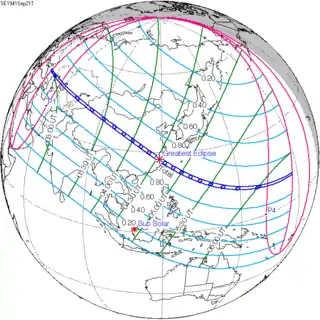 Map | |
| Type of eclipse | |
| Nature | Total |
| Gamma | 0.4649 |
| Magnitude | 1.0379 |
| Maximum eclipse | |
| Duration | 202 sec (3 m 22 s) |
| Coordinates | 27.3°N 119.1°E |
| Max. width of band | 143 km (89 mi) |
| Times (UTC) | |
| Greatest eclipse | 4:34:03 |
| References | |
| Saros | 143 (19 of 72) |
| Catalog # (SE5000) | 9378 |
Related eclipses
Solar eclipses of 1939–1942
This eclipse is a member of a semester series. An eclipse in a semester series of solar eclipses repeats approximately every 177 days and 4 hours (a semester) at alternating nodes of the Moon's orbit.[1]
| Solar eclipse series sets from 1939–1942 | ||||||
|---|---|---|---|---|---|---|
| Descending node | Ascending node | |||||
| Saros | Map | Saros | Map | |||
| 118 | April 19, 1939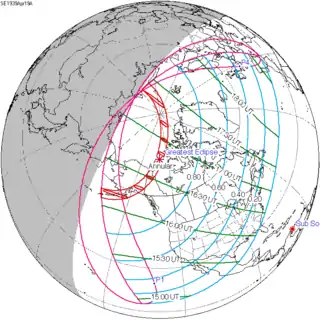 Annular |
123 | October 12, 1939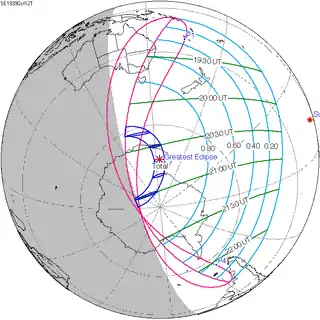 Total | |||
| 128 | April 7, 1940 Annular |
133 | October 1, 1940 Total | |||
| 138 | March 27, 1941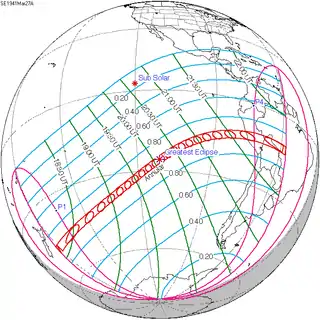 Annular |
143 | September 21, 1941 Total | |||
| 148 | March 16, 1942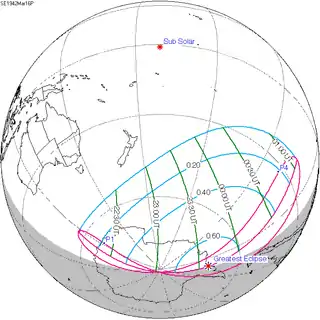 Partial |
153 | September 10, 1942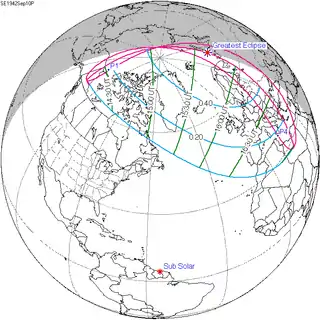 Partial | |||
| The partial solar eclipse on August 12, 1942 occurs in the next lunar year eclipse set. | ||||||
Saros 143
It is a part of Saros cycle 143, repeating every 18 years, 11 days, containing 72 events. The series started with partial solar eclipse on March 7, 1617 and total event from June 24, 1797 through October 24, 1995. It has hybrid eclipses from November 3, 2013 through December 6, 2067, and annular eclipses from December 16, 2085 through September 16, 2536. The series ends at member 72 as a partial eclipse on April 23, 2873. The longest duration of totality was 3 minutes, 50 seconds on August 19, 1887. All eclipses in this series occurs at the Moon’s ascending node.
| Series members 17–28 occur between 1741 and 2100 | ||
|---|---|---|
| 8 | 9 | 10 |
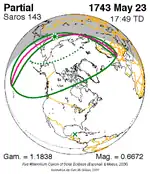 May 23, 1743 |
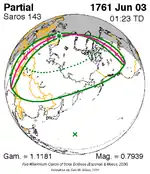 June 3, 1761 |
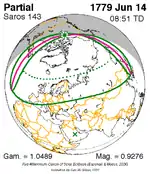 June 14, 1779 |
| 11 | 12 | 13 |
 June 24, 1797 |
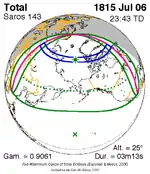 July 6, 1851 |
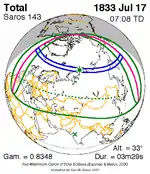 July 17, 1833 |
| 14 | 15 | 16 |
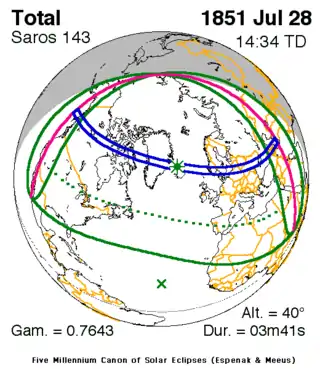 July 28, 1851 |
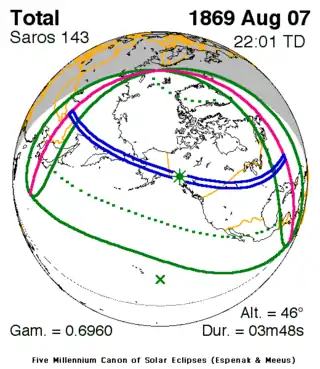 August 7, 1869 |
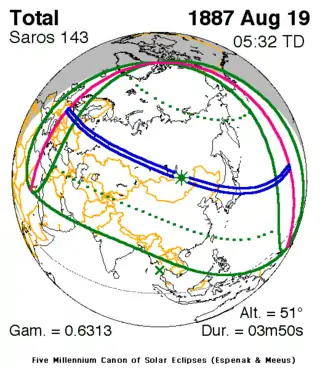 August 19, 1887 |
| 17 | 18 | 19 |
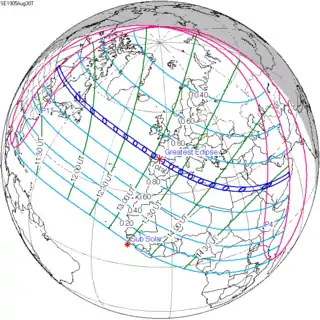 August 30, 1905 |
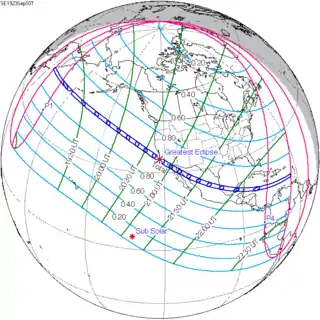 September 10, 1923 |
 September 21, 1941 |
| 20 | 21 | 22 |
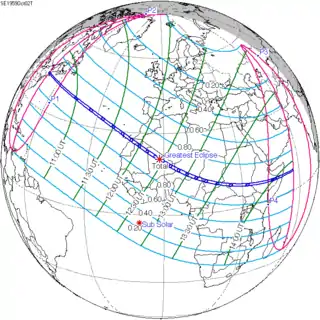 October 2, 1959 |
 October 12, 1977 |
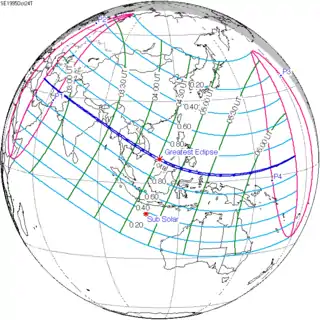 October 24, 1995 |
| 23 | 24 | 25 |
 November 3, 2013 |
 November 14, 2031 |
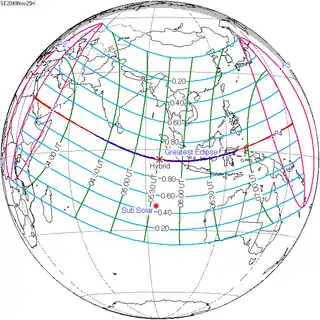 November 25, 2049 |
| 26 | 27 | 28 |
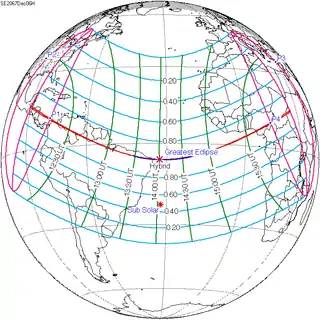 December 6, 2067 |
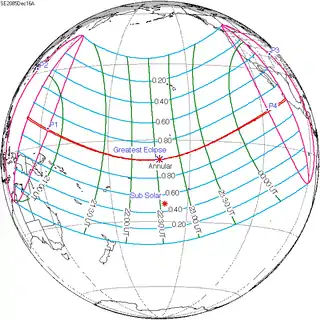 December 16, 2085 | |
References
- van Gent, R.H. "Solar- and Lunar-Eclipse Predictions from Antiquity to the Present". A Catalogue of Eclipse Cycles. Utrecht University. Retrieved 6 October 2018.
.jpg.webp)

